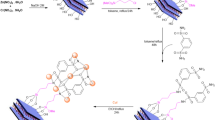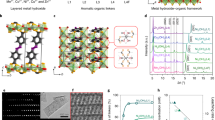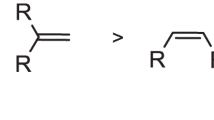Abstract
The manufacture of a range of bulk and fine chemicals, including flame retardants, disinfectants and antibacterial and antiviral drugs, involves bromination1. Conventional bromination methods typically use elemental bromine, a pollutant and a safety and health hazard. Attempts to develop alternative and more benign strategies have been inspired by haloperoxidase enzymes, which achieve selective halogenation at room temperature and nearly neutral pH by oxidizing inorganic halides with hydrogen peroxide2,3. The enzyme vanadium bromoperoxidase has attracted particular interest4,5 in this regard, and several homogeneous inorganic catalysts mimicking its activity are available6,7,8,9,10,11, although they are limited by the requirement for strongly acidic reaction media. A heterogenous mimic operating at neutral pH has also been reported12, but shows only modest catalytic activity. Here we describe a tungstate-exchanged layered double hydroxide that catalyses oxidative bromination and bromide-assisted epoxidation reactions in a selective manner. We find that the catalyst is over 100 times more active than its homogeneous analogue. The low cost and heterogeneous character of this system, together with its ability to operate efficiently under mild conditions using bromides rather than elemental bromine, raise the prospect of being able to develop a clean and efficient industrial route to brominated chemicals and drugs and epoxide intermediates.
This is a preview of subscription content, access via your institution
Access options
Subscribe to this journal
Receive 51 print issues and online access
$199.00 per year
only $3.90 per issue
Buy this article
- Purchase on Springer Link
- Instant access to full article PDF
Prices may be subject to local taxes which are calculated during checkout


Similar content being viewed by others
References
Ullmann's Encyclopedia of Industrial Chemistry 6th edn (Electronic release, Wiley-VCH, Weinheim, 1998).
Gribble, G. W. Naturally occurring organohalogen compounds. Acc. Chem. Res. 31, 141–152 (1998).
Butler, A. & Walker, J. V. Marine haloperoxidases. Chem. Rev. 93, 1937–1944 (1993).
Franssen, M. C. R. & van der Plas, H. C. Haloperoxidases: their properties and their use in organic synthesis. Adv. Appl. Microbiol. 37, 41–99 (1992).
Butler, A. in Bioinorganic Catalysis (ed. Reedijk, J.) Ch. 13 (Dekker, New York, 1993).
Conte, V., Di Furia, F. & Moro, S. Mimicking the vanadium bromoperoxidase reactions: mild and selective bromination of arenes and alkenes in a two-phase system. Tetrahedr. Lett. 35, 7429–7432 (1994).
Reynolds, M. S., Morandi, S. J., Raebiger, J. W., Melican, S. P. & Smith, S. P. E. Kinetics of bromide oxidation by (oxalato)oxodiperoxomolybdate(VI). Inorg. Chem. 33, 4977–4984 (1994).
Espenson, J. H., Pestovsky, O., Huston, P. & Staudt, S. Organometallic catalysis in aqueous solution: oxygen transfer to bromide. J. Am. Chem. Soc. 116, 2869–2877 (1994).
Clague, M. J. & Butler, A. On the mechanism of cis-dioxovanadium(V)-catalyzed oxidation of bromide by hydrogen peroxide: evidence for a reactive, binuclear vanadium(V) peroxo complex. J. Am. Chem. Soc. 117, 3475–3484 (1995).
Meister, G. E. & Butler, A. Molybdenum(VI)- and tungsten(VI)-mediated biomimetic chemistry of vanadium bromoperoxidase. Inorg. Chem. 33, 3269–3275 (1994).
Hamstra, B. J., Colpas, G. J. & Pecoraro, V. L. Reactivity of dioxovanadium(V) complexes with hydrogen peroxide: implications for vanadium haloperoxidase. Inorg. Chem. 37, 949–955 (1998).
Walker, J. V. et al. Peroxidative halogenation catalyzed by transition-metal-ion-grafted mesoporous silicate materials. J. Am. Chem. Soc. 119, 6921–6922 (1997).
Trifirò, F. & Vaccari, A. in Comprehensive Supramolecular Chemistry Vol. 7, 251 (Pergamon, Elsevier Science, Oxford, 1996).
Nakamoto, K. Infrared and Raman Spectra of Inorganic and Coordination Compounds (Wiley-Interscience, New York, 1986).
Soedjak, H. S. & Butler, A. Mechanism of dioxygen formation catalyzed by vanadium bromoperoxidase from Macrocystis pyrifera and Fucus distichus: steady state kinetic analysis and comparison to the mechanism of V-BrPO from Ascophyllum nodosum. Biochem. Biophys. Acta 1079, 1–7 (1991).
Held, A. M., Halko, D. J. & Hurst, J. K. Mechanisms of chlorine oxidation of hydrogen peroxide. J. Am. Chem. Soc. 100, 5732–5740 (1978).
Everett, R. R., Kanofsky, J. R. & Butler, A. Mechanistic investigations of the novel non-heme Vanadium bromoperoxidases. J. Biol. Chem. 265, 4908–4914 (1990).
Frimer, A. A. Singlet Oxygen (CRC, Boca Raton, Florida, 1985).
Schubert, W. M. & Keeffe, J. R. The acid-catalyzed hydration of styrenes. J. Am. Chem. Soc. 94, 559–566 (1972).
Yates, K., McDonald, R. S. & Shapiro, S. A. Kinetics and mechanisms of electrophilic addition. I. A comparison of second- and third-order brominations. J. Org. Chem. 38, 2460–2463 (1973).
Messerschmidt, A. & Wever, R. X-ray structure of a vanadium-containing enzyme: Chloroperoxidase from the fungus Curvularia inaequalis. Proc. Natl. Acad. Sci. USA 93, 392–396 (1996).
Kresge, C. T., Leonowicz, M. E., Roth, W. J., Vartuli, J. C. & Beck, J. S. Ordered mesoporous molecular sieves synthesized by a liquid-crystal template mechanism. Nature 359, 710–712 (1992).
Maschmeyer, T., Rey, T., Sankar, F. & Thomas, J. M. Heterogeneous catalysts obtained by grafting metallocene complexes onto mesoporous silica. Nature 378, 159–162 (1996).
Huybrechts, D. R. C., De Bruycker, L. & Jacobs, P. A. Oxyfunctionalization of alkanes with hydrogen peroxide on titanium silicalite. Nature 345, 240–242 (1990).
Knops-Gerrits, P.-P., De Vos, D., Thibault-Starzyk, F. & Jacobs, P. A. Zeolite-encapsulated Mn(II) complexes as catalysts for selective alkene oxidation. Nature 369, 543–546 (1994).
Kadima, T. A. & Pickard, M. A. Immobilization of chloroperoxidase on aminopropyl-glass. Appl. Environ. Microbiol. 56, 3473–3477 (1990).
Roouhi, M. New reaction uncouples epoxidation from acidity. Chem. Eng. News 7 July, 6–7 (1997).
Itoh, N., Cheng, L., Izumi, Y. & Yamada, H. Immobilized bromoperoxidase of Corallina pilulifera as a multifunctional halogenating biocatalyst. J. Biotechnol. 5, 29–38 (1987).
Aoun, S. & Baboulène, M. Regioselective bromohydroxylation of alkenes catalyzed by chloroperoxidase: Advantages of the immobilization on talc. J. Mol. Catal. B 4, 101–109 (1998).
Sheldon, R. A. & Kochi, J. K. Metal-Catalyzed Oxidation of Organic Compounds (Academic, New York, 1981).
Sels, B. F., De Vos, D. E. & Jacobs, P. A. Selective epoxidations involving anionic peroxotungsten compounds generated in situ on layered double hydroxides with various polarities. Tetrahedr. Lett. 37, 8557–8560 (1996).
Acknowledgements
We thank the Belgian Ministry of Science Policy for IUAP-PAI sponsoring; B.S., D.D.V. and F.P. acknowledge fellowships from IWT, FWP and IRSIA.
Author information
Authors and Affiliations
Corresponding author
Rights and permissions
About this article
Cite this article
Sels, B., Vos, D., Buntinx, M. et al. Layered double hydroxides exchanged with tungstate as biomimetic catalysts for mild oxidative bromination. Nature 400, 855–857 (1999). https://doi.org/10.1038/23674
Received:
Accepted:
Issue Date:
DOI: https://doi.org/10.1038/23674
This article is cited by
-
High-throughput synthesis of CeO2 nanoparticles for transparent nanocomposites repelling Pseudomonas aeruginosa biofilms
Scientific Reports (2022)
-
W/HAP catalysed N-oxidation of tertiary amines with H2O2 as an oxidant
Journal of Chemical Sciences (2022)
-
Peroxo–tungstate(VI) complexes: syntheses, characterization, reactivity, and DFT studies
Monatshefte für Chemie - Chemical Monthly (2019)
-
Enhancement of the productivity of the potent bacteriocin avicin A and improvement of its stability using nanotechnology approaches
Scientific Reports (2017)
-
Facile preparation and electrochemical characterization of kassite-based materials for supercapacitor applications
Applied Physics A (2017)
Comments
By submitting a comment you agree to abide by our Terms and Community Guidelines. If you find something abusive or that does not comply with our terms or guidelines please flag it as inappropriate.



